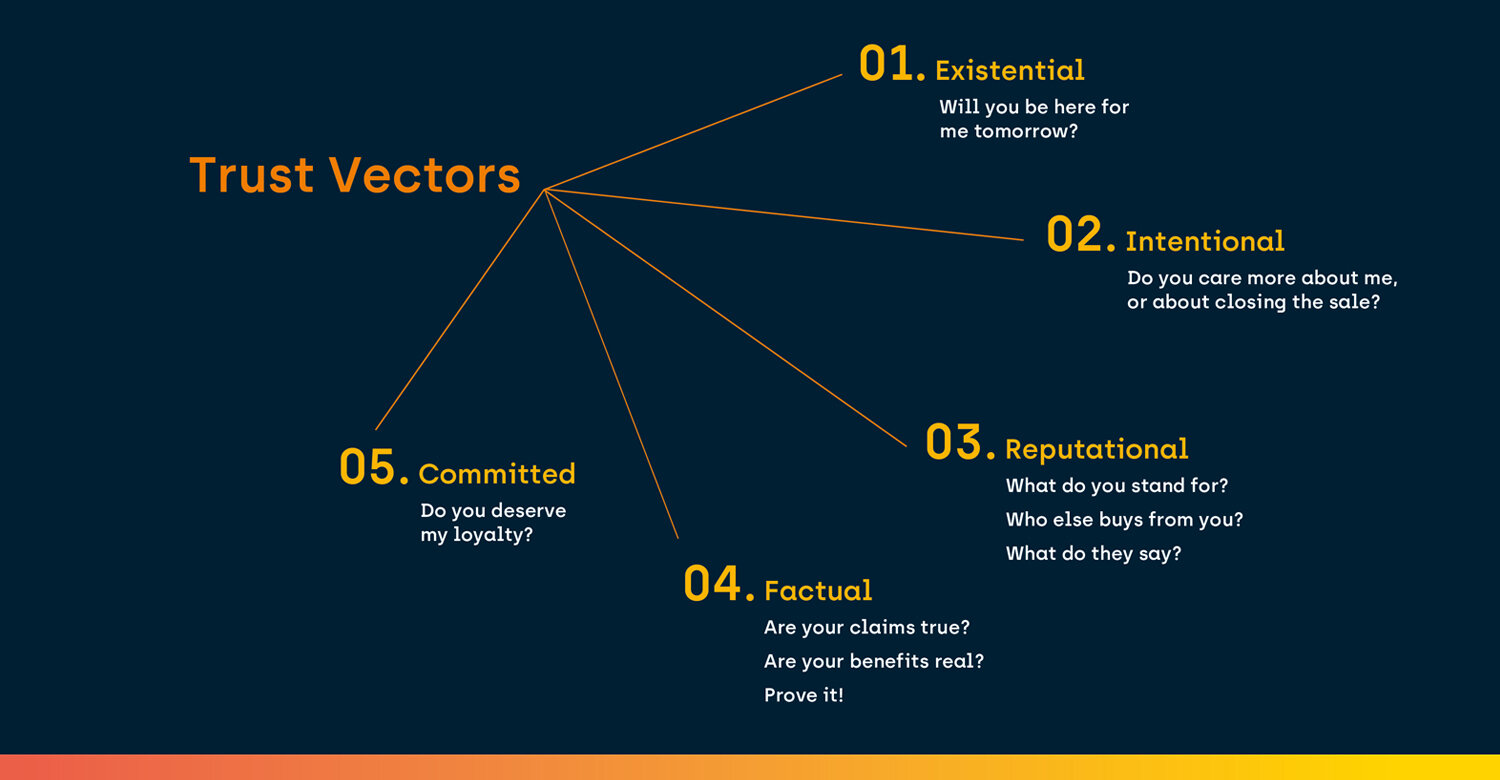Intentional Trust: Customers see right through you.
If customers sense that you care less about them and more about closing the sale, they will bounce.
What’s your Intentional Trust score?
Intentional trust is the brand equity you earn when customers feel valued and know in their guts that you won’t let them down. It’s a powerful component of brand trust that too often slips away quietly, one misguided cost-cutting or short-term revenue-boosting policy at a time. Before you know it, they’ve moved their loyalty to your competitors, never to return.
Intentional Trust is gained or lost early in the customer journey…just as a prospect experiences a company’s communications for the first time, and it continues to be vulnerable throughout the relationship, at every touchpoint.
Customers value trust over price and ease of use, according to Five9 Customer Service index.
Four steps to rebuild Intentional Trust
Step 1: Take the Infinite Edge Brand Trust Assessment.
With the help of culture experts, social scientists, business gurus, and reputation firms, we’ve defined five different trust vectors, each with questions potential customers need you to address and act upon before they feel safe doing business with you. The companies that survive and thrive in these trying times will be the ones who diligently tend all five trust vectors and make it their mission to enlist every employee in maintaining them long-term.
Use your score as a benchmark to guide future improvements in your company policies, then retake the test periodically to track your progress. If your score is already high, focus on the areas that need improvement, and review how you can make your strong points even stronger. If your score is average (medium), that’s not necessarily a good thing if your goal is growth and competitive advantage, so make trust-building a priority asap. And if your score is on the low side, use the feedback you receive from the assessment to identify opportunities to make measurable improvements in your company’s processes and policies.
Step 2: Refresh your approach to marketing planning. Things have changed.
Knowing that your marketing efforts will be hamstrung by a lack of intentional brand trust, here are some steps you can take within your own department to realign your efforts with customer needs.
Research your customers’ attitudes and changing expectations. Customer priorities and values have shifted dramatically, especially in the past year. Issues like unity, transparency, data protection, climate change, social equality, and community have moved to the forefront, surpassing price, convenience, and even brand recognition.
Conduct customer satisfaction research to learn why prospects leave before buying, or fail to become repeat purchasers. This will reveal new opportunities for closing trust gaps and inspiring more sales.
Develop new personas, looking for fresh opportunities to resonate with prospects on a more trustworthy level.
Review your brand voice. Is it human, honest, and helpful or preachy, arrogant, impersonal, or otherwise off-putting?
Revise your marketing plan to focus on efforts that build connection and address real customer concerns.
Step 3: Partner closely with Sales.
We hear many consumer complaints about companies who will say anything to close the deal. Salespeople can inadvertently lose sales by overpromising or coming across as greedy, indifferent, or impersonal. Marketing can help Sales focus on building relationships based on trust and integrity
Share your Infinite Edge Brand Trust Assessment results and help sales leaders understand the connection between trust and sales.
Share your fresh consumer research with them and offer to facilitate training sessions to reflect a focus on transparency, honesty, and relationship-building.
Empower sales and support teams to go the extra mile to make customers feel valued, whether this means throwing in “extras” to close the deal, free product training after the sale, or extended terms.
Encourage sales to communicate openly with customers when problems with supply, product quality, delivery delays, etc. occur.
Discourage the practice of upselling when it doesn’t match customer needs.
Step 4: Take it all the way to the top.
Intentional trust gets lost when the company forgets to put customers first. As we mentioned above, company-wide policies can erode trust in serious, if well-intentioned ways.
Pressure from shareholders and/or Finance can create cost-cutting measures that favor automated customer service over human interactions, strict return policies, IT budget reductions, and even the sale of customer data for a profit.
The resulting short-term savings will backfire, as customers leave to seek vendors who make a greater effort to protect their interests.
Be on the lookout for opportunities to strengthen your Intentional Trust quotient by thinking outside the limits of Marketing’s defined responsibilities. And don’t be discouraged when you encounter resistance to suggested changes in policies and procedures. Intentional trust gets lost when the company forgets to put customers first. As we mentioned above, company-wide policies can erode trust in serious, if well-intentioned ways.
Pressure from shareholders and/or Finance can create cost-cutting measures that favor automated customer service over human interactions, strict return policies, IT budget reductions, and even the sale of customer data for a profit. The resulting short-term savings will backfire, as customers leave to seek vendors who make a greater effort to protect their interests.
Be on the lookout for opportunities to strengthen your Intentional Trust quotient by thinking outside the limits of Marketing’s defined responsibilities. And don’t be discouraged when you encounter resistance to suggested changes in policies and procedures.
The results of your Brand Trust Assessment can open the doors to real change with top management, Finance, Customer Service, IT, and even Product Design. HR can become a real ally in implementing system-wide change with training modules that emphasize the importance of building strong customer relationships. You can also share our Brand Trust Whitepaper with key stakeholders to support your plan.
If the prospect of leading company-wide change seems daunting, call us in to advise you and develop a plan. As a marketing/consulting firm with a twist, that’s what we do.
InfiniteEdge is a consultancy of marketing and culture experts that helps companies build trust and navigate today’s rapidly evolving market environment, while providing all the marketing services you'd expect from a top-tier integrated agency. Invite us in to help you transition your marketing operation from reactive to responsive and develop a roadmap to help you thrive through the coming unknown.




